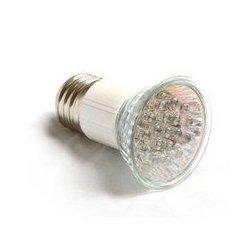So you want to know why a solar LED light is a good idea for your yard?
Well, there’s a great answer to that, but first why don’t we take a look at where exactly the LED light came from.
After all, we see these lights in our flashlights and on our Christmas trees and we may soon be using them to replace our incandescent light bulbs. We might as well start to learn a little something about them.
First things first: With a solar LED light, the LED stands for “light emitting diode”. This is a solid-state lighting technology which means that the light is emitted from a solid object (a semiconductor) and not a vacuum or gas tube.
The infrared LED was first patented in 1961 by two Texas Instruments researchers. Since infrared light is invisible to the naked eye, this first LED didn’t look too promising as a light source.
This all changed the next year when General Electric’s Nick Holonyak, Jr. invented an LED that emitted visible red light.
As early as 1963, Mr. Holonyak even predicted that his LEDs would replace the incandescent light bulb invented by Thomas Edison.
Big words.
What could have inspired such confidence in Mr. Holonyak? What did his LEDs have to offer that could make Thomas Edison’s incandescent bulb obsolete?
Good question.
Part of the answer involves efficiency. One of the main advantages of LED lights is the fact that they are a lot more efficient than traditional incandescent light bulbs. In fact, according to the New York Times, LEDs are more than twice as efficient as compact fluorescent bulbs (CFLs).

Although there are some disagreements over how light bulb efficiency is measured, the LED definitely seems to hold its own in the efficiency department. A recent article in Popular Mechanics stated that the Definity LED delivers 112 lumens per watt compared with the 50 to 70 lumens per watt of a CFL.
Of course, what good is efficiency if it doesn’t translate to our pocketbooks? Fortunately ‘light emitting diodes’ have this covered.
The Department of Energy estimates that if we replaced all of our regular light bulbs with LEDs we would save “the equivalent annual electrical output of about 24 large power plants”. This would mean about 15 billion dollars in energy savings per year.
So efficiency and the resulting cost savings are the big bonus of a solar LED light.
Another advantage of LEDs is how long they last.
Traditional incandescent light bulbs have a lifespan of 750 to 1000 hours. Compact fluorescent lamps improved on this and have a rated lifespan of 6000 to 15 000 hours. LEDs take this to a whole new level with a general life expectancy of 50 000 hours.
This increased lifespan saves you money since you don’t have to purchase lights as often. It also helps the environment since you will be disposing of less waste. A third advantage of the longer LED life is that you will save time by not having to change as many light bulbs.
This may not seem like a big deal but it can be especially helpful in large commercial operations where changing thousands of light bulbs can be a costly maintenance job.
A third advantage of LEDs is their lack of toxic substances. Compact fluorescent bulbs contain mercury and need to be disposed of carefully. The Environmental Protection Agency recommends contacting your state or local environmental regulatory agency for specific disposal guidelines regarding CFLs.
Since LEDs are mercury free, there are no such environmental concerns with disposal. Also, there is no risk of mercury exposure with a broken LED.
So now you know why LED inventor Nick Holonyak was so confident that his lights would make the incandescent light bulb obsolete. In short, LEDs are more efficient, longer lasting, and less toxic than other available lighting options.
For more information about your solar LED light options, be sure to check out our page on LED solar lights.
